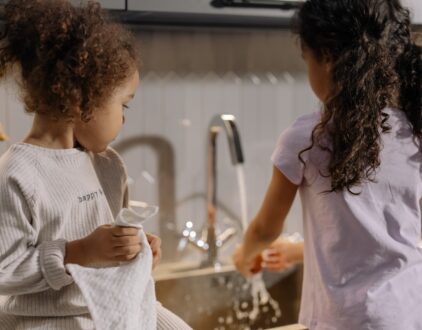Given the chaos of our recent past—looking at you, COVID—it makes sense that we have a heightened concern about infection-causing germs in our homes and immediate surroundings. Whether you’re a clean freak or just want to be more informed about keeping a disinfected home, break down the science behind disinfecting and learn ways to keep your home germ-free.
The Basics of Germs
Germs are an umbrella term for bacteria, viruses, and fungi that can lurk on surfaces, waiting for an opportunity to grow and spread. They are tiny, resilient, and often invisible to the naked eye.
Going another layer deeper, bacteria are single-celled organisms that can multiply rapidly, while viruses are even smaller and can only reproduce within a host cell. Fungi, such as mold and mildew, thrive in damp environments. The key to protecting your home is knowing where they hide and how to eliminate them effectively.

Understanding Disinfection
Disinfection is the process of eliminating or reducing the number of germs on surfaces to a safe level. It involves the use of chemical agents specifically designed to kill or inhibit the growth of these microscopic invaders. When done correctly, disinfection can significantly reduce the risk of infections in your household.
The idea behind disinfection revolves around the concept of disrupting the germs’ vital processes. Different disinfectants work in various ways. Some break down the cell walls of bacteria, while others disrupt the genetic material of viruses. Choosing the right disinfectant depends on the type of germs you want to target.
Choosing the Right Disinfectant
This is a big one—not all disinfectants are created equal. To effectively combat germs, it’s crucial to choose the right disinfectant for the job. Look for products that are EPA-approved and have demonstrated efficacy against a broad spectrum of pathogens.
Common household disinfectants include alcohol-based solutions, bleach, and hydrogen peroxide. Alcohol-based solutions are effective against bacteria and some viruses, while bleach is a powerful all-purpose disinfectant. Hydrogen peroxide is excellent for eliminating mold and mildew. Always check the product label for usage instructions and safety precautions.
If you have sensitivities to these harsh chemicals or would rather avoid introducing them to your home, there are plenty of all-natural, eco-friendly products that get the job done just as well.

Proper Cleaning Techniques
Cleaning is the first step in the disinfection process. Before applying any disinfectant, it’s important to remove dirt, dust, and debris from surfaces. Use soap and water or the appropriate cleaner to clean surfaces thoroughly, and don’t forget high-touch areas like doorknobs, light switches, and countertops.
Application and Contact Time
When applying a disinfectant, follow the product’s instructions carefully. Make sure that you apply enough disinfectant to keep the surface visibly wet for the recommended contact time. This allows the disinfectant to do its job effectively and kill germs lurking on the surface.
Don’t Forget Your Gadgets!
In our technology-driven world, our gadgets are in constant use and are often overlooked when it comes to disinfection. Smartphones, tablets, laptops and even remotes are breeding grounds for germs, with studies showing that they can be dirtier than a toilet seat. Use disinfectant wipes specifically designed for electronics to keep your devices germ-free without causing damage.

Regularity Is Key
Disinfection should be a regular part of your cleaning routine, not just a reactive measure during outbreaks. High-touch surfaces should be disinfected daily, while other areas can be done weekly. Consistency is key to maintaining a germ-free environment.
Ventilation and Sunlight
Proper ventilation and sunlight can also play a big role in reducing the presence of germs in your home. Fresh air does more than just benefit your senses. Opening windows to allow fresh air to circulate and letting sunlight in can help kill bacteria and viruses naturally.
Ventilation helps to remove indoor air pollutants and bring in fresh, clean air. Sunlight, on the other hand, has natural disinfectant properties due to its ultraviolet, or UV rays. UV light can break down the DNA of germs, rendering them harmless.
popular posts
- 1It’s Black Business Month, So Let’s Go Shopping and #BuyBlack!
- 2These Home Decor Items Will Instantly Make Your Space Look Outdated
- 3Black-Owned Home Decor Stores To Support Across the United States
- 4A Look Inside Elon Musk's Tiny $50,000 House
- 57 Black and Multicultural Designers To Follow For Design Inspo

Home & Texture Editor's Picks: The 5 Best Vacuums on Amazon
by Stephanie Taylor | February 2, 2023

7 New And Bestselling simplehuman Products To Help Your Home Run Smoothly
by Stephanie Taylor | February 15, 2023

Product Review: Here's What We Think About The Levoit LV600s Humidifier
by Nneya Richards | February 22, 2023
Spaces
Whether it’s luxury or ease, every area of your home should be as fabulous and unique as you.

A New Study Reveals That This Item Has More Germs Than A Toilet Bowl
by Kelsey Marie | April 25, 2023
FOLLOW ALONG ON INSTAGRAM
#homeandtexture
Find us on social for more home inspiration where culture, personal style, and sophisticated shopping intersect to help you create a home where you love to live.




